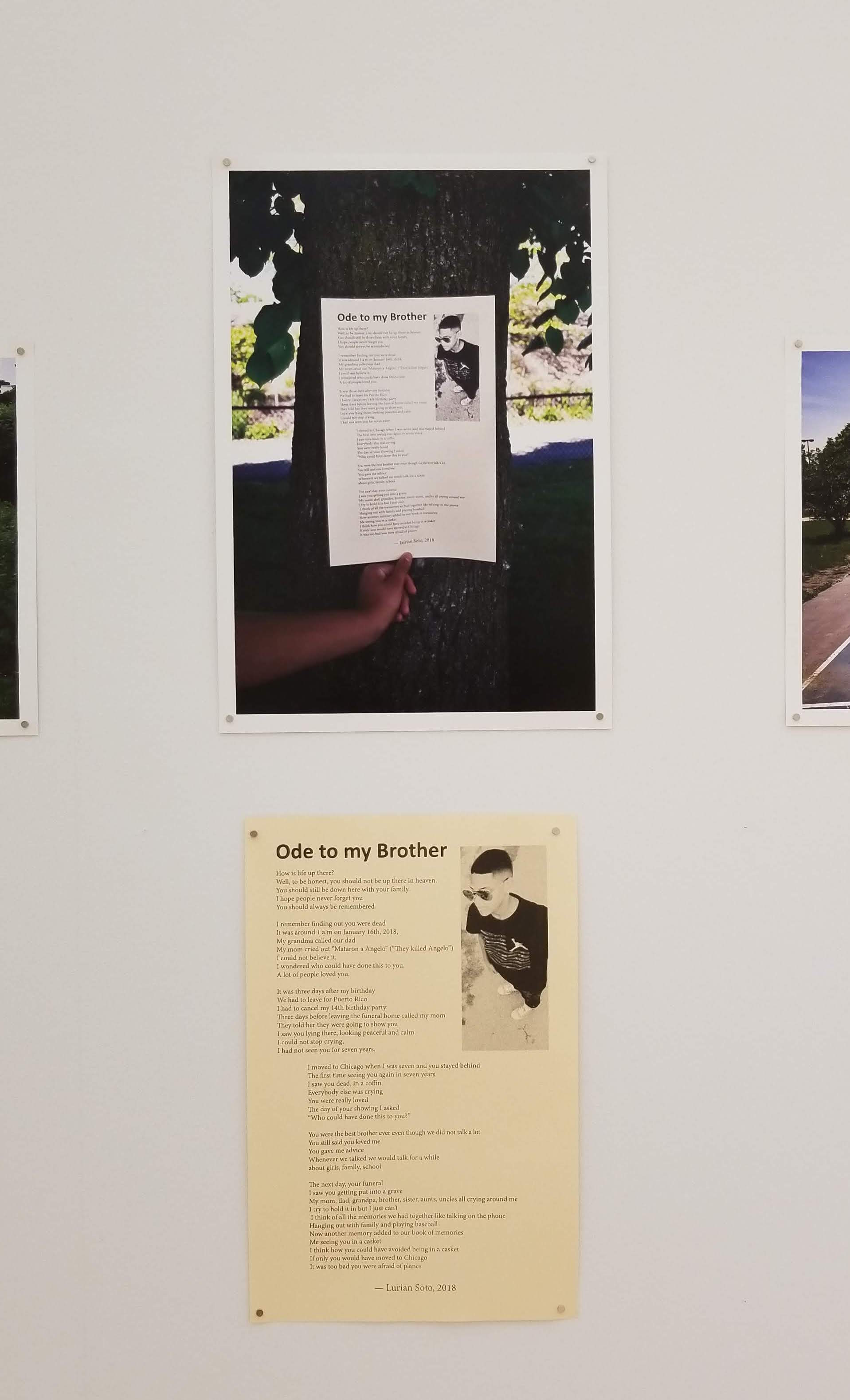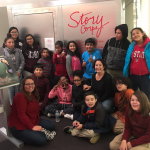Odes and Tattoos: Classroom Perspectives
How are voices and stories from overlooked, liminal social spaces elevated? How are marginalized cultural perspectives depicted to convey new ideas of self and community that are often sidelined by a larger historical narrative?
Odes and Tattoos, an exhibition of art from CAPE students at North-Grand High School in Humboldt Park, attempts to tackle these questions through the creation of multidisciplinary artworks that examine how history and culture are manifested through art. Through their work with CAPE Teaching Artists Marc Fischer and Jose Luis Benavides and teachers Karen Furlong and Lisa Welsh, the students also explored how they themselves can find agency by re-presenting the social and cultural. Odes and Tattoos is a multimedia exhibit of work by student artists who studied, explored, and rendered visually the ode as a poetic commemorative device, and tattoos as visual markers of personal events and histories.
We spoke with the participating teachers and teaching artists about the work, the exhibition, and the creative processes and struggles undertaken by the student artists. (Click here to learn more about the Odes and Tattoos exhibition and its ongoing events.)
How do you hope the public will engage with Odes and Tattoos?
Lisa Welsh: People have very different opinions about tattoos, both good and bad. I hope that people will look at our exhibit and not pass it by simply because they think tattoos are awful. My hope is that the exhibit will invite people to look at tattoos as a part of a person’s identity, as a part of someone’s story, and/or a part of their culture. It is my hope that after leaving our exhibit, people will not judge a person’s tattoo, but consider the history behind it.
Marc Fischer: The works in this show represent the perspectives of students who are mostly living in underserved neighborhoods in Chicago. Many of these students are grappling with difficult family and living situations. I hope that the public will be receptive to the creativity of these young people, which may not always have the polish and finesse that they expect from art, but nonetheless conveys a great deal of thought and power. It has been gratifying to see visitors taking the free posters of student poems, or photographing their favorite poems with their phones. The work is intended to reach into the lives of viewers and I hope that visitors will extend the exhibit by sharing and displaying the works they are able to document or take copies of.
What felt like your biggest challenge or surprise on the Odes and Tattoos journey?
MF: It took some time for the students to get comfortable writing about subjects that had strong personal meaning. After two of the students shared emotionally generous poems about personal tragedies, it seemed to give the rest of the class permission to take on more challenging subjects. I was moved by the strength and courage of their writings. Sharing personal details of their lives with an audience of many thousands of people is a big deal, and the students surprised me with their open-hearted approach to writing. Many of the students took obvious personal risks by choosing to write about difficult subjects such as their relationships with specific family members.
What questions does Odes and Tattoos inspire you to ask? What questions does it answer for you?
Jose Luis Benavides: For the Tattoo art class, we explored questions of racial identity, which tribes and ethnicities we are part of, and how we understand the connections between our culture and others. The course also helped all of us examine the legacies of colonialism to today and challenge our perceptions or stereotypes of incarcerated people. Through exploring tattoo art and design history, techniques, and perspectives we were able to get into deep conversations about stigmatization, stereotypes and racism in and targeted toward our communities.
How has the creation and exhibition of the work in Odes and Tattoos impacted your teaching practice? What did you learn or reconsider through your role as a teacher or teaching artist in the project?
MF: Most of the students in our class see downtown Chicago only very rarely. Few, if any, had ever visited the Chicago Cultural Center before and most of the students did not know what this building is. Many of the students rarely leave their own neighborhood. Exhibitions create opportunities to engage with other parts of the city in order to reach new audiences. I increasingly feel that in my role as a teaching artist, I need to work with students on projects that will help them feel greater ownership of the city they live in, and know that the city’s resources are for them. Many of the students still have not been able to attend their own exhibit but I look forward to hearing their thoughts once they’ve had that experience.
How did the exploration of different materials impact student dialogue about the subject matter?
LW: Our students were really excited to talk about, design, and create tattoos. As we explored the cultural connections from societies around the world, students understood them as more than ink to put on the body. The idea of the tattoo as a story or personal history became more and more important as the project progressed. There were two moments, in particular, that I think had the most impact on the students. One, the Dr. Lakra-inspired artwork, where our students took advertisements and images from magazines and “tattooed” the individuals pictured. You have these photoshopped images of men and women, these images of “perfect” people, and students are changing who (or what) is being presented to the world through the “tattooing” of the images. Students were able to think about and question the idea of beauty, as well as to consider how tattoos change our perception of the person in the ad, both positively and negatively.
That particular exercise also connects to the second powerful moment of the project: Students viewed a short film about gang members and ex-convicts who were covered in gang and prison tattoos, and who, through the magic of photoshop, had all of their tattoos removed. The film allowed us to see their reactions to the new images, but it also was very shocking to see how our own perceptions of these men changed with the altered images.
Why is Odes and Tattoos important to you, your students, and their families?
JLB: As a teaching artist I approached this class wondering just how students would connect to these topics and the issues raised in the art making and discussion we had throughout the year. It was important to me to think of a way to use tattoo art and tattoo history as away to investigate our connections to history and our own place in society today.









